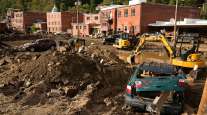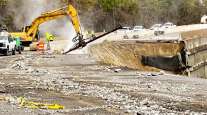Road Building in North Carolina ‘Data Driven’ After Passing of Bill to Remove Politics From Transportation

In the old days, getting a road built often meant a powerful legislator making a call, pressuring agency employees and then appearing at a ribbon-cutting ceremony for the shiny new road.
Then in 2013, the North Carolina General Assembly passed House Bill 817, setting up a comprehensive "points" system that ranks road projects based on need, meaning phone calls from powerful legislators don't move any needles.
"The intent was to take politics out of transportation decision-making," said Nicole Meister, spokeswoman for the North Carolina State Transportation Improvement Program. "It's a data-driven process."
State sources make up about 80% of the DOT's $4.4 billion budget, with federal sources making up the rest.
About 60% of the state's money comes from a motor fuel taxes paid at the pump, 25% comes from Department of Motor Vehicle (DMV) fees like those issued for registering cars and issuing driver's licenses, and 15% is derived from the highway use tax, which is 3% of a vehicle's net retail value when a certificate of title is issued in North Carolina.
High Costs
The costs, Meister said, to repair, maintain or build new roads may seem staggering on the surface — $200 to fill a pothole, $200,000 to resurface a mile of two-lane road, up to $2 million to upgrade a mile of an existing four-lane road to interstate quality, and $3-4 million per mile to build a new two-lane road.
To build a new interstate-quality road? About $30 million per mile on average.
But more goes into building a new road than new pavement and markings, Meister said. It is the tasks beyond building the new road that make projects so expensive and lengthy.
The DOT has to pay to acquire land and rights-of-way, move utilities, mitigate wetlands and meet other environmental concerns, design the projects and buy new signs, all of which build up the cost beyond the construction costs for the roads, interchanges and bridges.
"A lot goes into it," Meister said. "It can be a complex process."
Getting Funded
N.C. Sen. Bill Rabon, (R-Brunswick), said he believed Southeastern North Carolina was getting its fair share of road construction dollars through the apolitical point system, something he has called one of the General Assembly's finest achievements over the last few years.
But the law isn't blind to local needs, Meister said. It allows local interests to assign "points" to local projects — beyond those deemed statewide priorities — under which local DOT divisions would rank projects that ultimately would be funded by need and merit.
"It also provides flexibility to meet needs of local communities," she said.
Further, legislators enacted rules last year that mean they can no longer raid the state's highway transportation fund to supplement the general fund. Meister said that, for the six-county DOT division that includes New Hanover, Brunswick and Pender counties, the change meant an increase in maintenance funding from about $39 million to $44.6 million this fiscal year.
"It has provided additional revenue," Meister said of the change. With that additional revenue, the DOT was able to move 127 projects into the program's 10-year window that were not originally included.
Delays
Locally, the DOT has identified several projects it plans to fund and eventually build. But it can take a decade. For example, establishing a new configuration for the intersection of Oleander Drive and South College Road — Wilmington's busiest intersection — is in early planning stages. Officials project construction will begin in 2025.
"If there is any shortfall, it's in project delivery," Rabon said. "North Carolina is simply not being efficient. Funding is not the problem. It's getting the money that's just sitting there actually spent."
Rabon said delays are often caused by how long it takes to study environmental impacts and to buy property sitting in the projected path of the road. Environmental studies can often feature a government agency — the NCDOT — butting heads with other government agencies that regulate environmental impacts.
And buying property can often feature lawsuits dragging out the process, as the DOT has frequently been accused of attempting to lowball property owners.
"We're not getting the projects delivered in a timely fashion," Rabon said. "Environmental mitigation and right-of-way acquisition are the biggest parts. They can take years."
Rabon said that, now that politics has been taken out of the road project equation, his next goal is trimming the amount of time it takes to drive on fresh asphalt.
"There could be more streamlining to cut down on the bureaucracy," he said.




